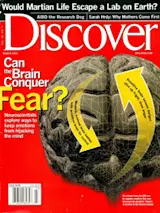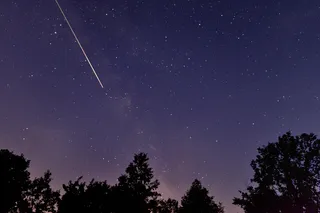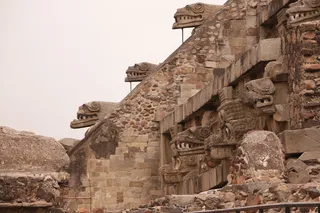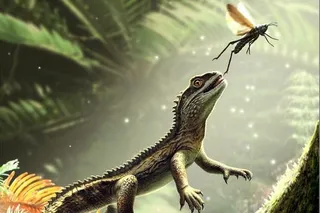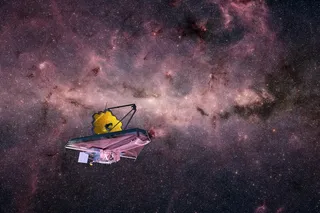Museums
Aztecs The Royal Academy of Arts, London Through April 11, 2003www.aztecs.org.uk
Of the 350 artifacts of Aztec culture now on display at the Royal Academy of Arts in London, the most discomfiting is a two-foot-tall clay statuette of Xipe Totec, the ancient Aztec god of spring. The name translates as "our flayed lord," and the sculpture depicts him dressed in an oddly bobbled tunic—the clay facsimile, it turns out, of a human skin turned inside out. The bobbles represent the globules of fat that lie beneath human skin, a phenomenon that, as the surrounding exhibit makes unflinchingly clear, was entirely familiar to Aztec artists. For certain rituals, Aztec priests donned flayed human skins, complete with the victim's scalp and face, and continued to wear them for 20 days or more, until the rotting garment fell away. Thus new life sprang from the old, and the return of spring—for everyone except one unfortunate soul—was insured. The most comprehensive Aztec exhibition ever mounted provides a riveting portrait of a society obsessed with the natural cycle of life and death—a fiercely refined culture in which nobility and war, scholarship and human sacrifice went hand in severed hand. The Aztec empire flourished from 1325 to 1521; at its peak it stretched from central Mexico to Guatemala. The exhibition includes objects and artwork culled from museums around the world: stone calendars, feathered shields, lavishly illustrated deerskin books, and a gruesome array of ritual knives.
The Aztecs' cultural and spiritual life centered on Templo Mayor, a stone temple that towered above the rest of the ancient capital Tenochtitlán, now beneath modern-day Mexico City. First built in 1325, the temple was expanded six times over the subsequent two centuries, and each new version encased the previous one like a thick skin of stone. Largely dismantled by the Spanish in the 16th century, Templo Mayor—along with many of the artifacts currently on display—was rediscovered in 1978 in the heart of Mexico City. A video sequence early in the exhibition shows a time-lapse computer re-creation, in which, layer by layer, the temple edifice is built into an ever grander structure. The sequence neatly encapsulates the guiding philosophy of the Aztecs: Life thrives only by the grace of the dead.
As the Aztecs well knew, theirs was not the first culture to inhabit the region. The Olmecs, Maya, and Toltecs had all come and gone by A.D. 700. Some of what modern scholars know about those cultures stems from the Aztecs' own fascination with those who came before them. They visited and excavated the ruined cities of their predecessors and assimilated the old gods, calendars, writing, and crafts.
From borrowed beginnings the Aztecs invented a rich culture of their own. Hand-painted pictographic manuscripts, or codices, of which several exquisite examples are on exhibit, offer modern scholars a window into daily Aztec life. A complex, two-calendar system enabled the Aztecs to track seasons and crop schedules. And a variety of intricately carved animal sculptures—lizards, serpents, eagles, even an oversize stone carving of a flea, with careful attention given to its bloodsucking mouth parts—attest both to the Aztecs' skills as artisans and their abiding interest in the natural world. Being the center of the universe (as they saw themselves), the Aztecs felt obliged to monitor its rhythms and contents, lest the whole thing fall apart.
Human sacrifice was integral to this cosmic upkeep. The gods had killed, flayed, dismembered, or otherwise disembodied themselves to create the Aztecs' world, and the Aztecs apparently felt obligated to repay the debt in kind. Hence the finely ornamented flint knives that were used to cut open the breastbones of living victims; hence the admirable skill devoted to creating clay and stone urns to hold drained blood and vital organs. The voice on the exhibition audio guide assures the listener that, to the Aztecs, "a good death was a violent death." Standing amid such articles of pain, however, one wonders how widely this view was shared. The caption beneath a statuette of a hunchbacked man dryly notes that deformed individuals were cared for by the Aztec state "until a solar eclipse took place, at which point they were the first to be sacrificed."
With the occasional exception of the physically handicapped, most sacrificial victims were captives of war. Indeed, Aztec warfare was highly ritualized, its sole purpose not to kill opponents but to capture them. Warriors entered battle adorned in feathers, jewels, and jingling bells. Fearsome as they were in this specialized activity, the Aztecs were no match for Spanish soldiers, who marched on the city in 1521 intent on killing and conquering, not taking captives. An illustration from the Codex Azcatitlán shows a column of armored horsemen advancing on a group of Aztecs, nattily attired in eagle costumes, with the ease of tanks crossing a field of flowering teasels. After 93 days of siege and starvation, the Aztec empire, so fully committed to the worship of death and regeneration, found itself on the losing end of the equation. The transition to Christianity, the largest mass conversion in history, was soon under way.
Even in defeat the Aztec spirit continued to thrive. Small shrines to the ancient gods appeared in the region well into the 19th century. One of the most beautiful artifacts in the exhibit is a portrait of the Mass of St. Gregory, dating from 1539, rendered entirely in Aztec style with small blue feathers. As for Templo Mayor, it was flayed by the Spanish, its skins of stone removed and recycled in the founding of Mexico City. And there they remain: underfoot, bearing the weight of the living.
Poetry
Animal Sense By Diane Ackerman, illustrated by Peter Sís Alfred A. Knopf, $14.95
In every steely, cold, rational science maven's heart runs a red-hot stream of romance. Finding the stream and allowing yourself to get in touch with it is what's difficult. To the rescue comes the always iconoclastic Diane Ackerman, author of A Natural History of the Senses. (And let's stop for a moment to discuss priorities: If you haven't read that book, put down this review and run for the nearest library.)
Ackerman's lovely little book of poetry will appear at first glance to be a good gift for a child, and indeed a child would be handy to have around so you could justify reading the book aloud. It is more than that, though. It is a book for the curious child in each of us, and lots and lots of the clever wordplay is as much to an adult's liking as the words in Dr. Seuss's Cat in the Hat. There is also a lot of learning to be had here (I suspect she couldn't help herself). Try this—aloud, please—for a tickle of an example.
Swans are not white—they're clear. The same is true of polar bears. And blue jays are certainly not blue, but also clear. Perhaps you knew. In nature, colors aren't what they appear, but subtle and tricky, and ever so quaint. So, animal colors are rarely like paint. Tiny air bubbles inside swan feathers trap all the colors, splash them together, and abracadabra! We think we see white there, but as I said, swans are actually clear. The same is true of polar bears. And blue jays are certainly not blue, but also clear. Perhaps you knew.
Don't make the mistake of reading it once. Read it at least three times. Then you'll understand why a scientist like Carl Sagan was crazy about this woman.
— Stephen L. Petranek
Books
The Extravagant Universe: Exploding Stars, Dark Energy, and the Accelerating Cosmos
By Robert P. Kirshner Princeton University Press, $29.95
In 1917 Albert Einstein uncovered evidence of a powerful cosmic force that no one had previously suspected. Astronomers and physicists had long assumed that remote stars and galaxies drifted around at random, like dust motes in a sunbeam, while the universe itself remained static. Yet young Einstein's equations indicated that, without a force to counterbalance gravitation, the natural attraction of everything in the universe to everything else would set the universe into some sort of systematic motion—either contraction or an ever-slowing expansion.
So he added a term to his relativistic equations to represent the compensating force that would keep the universe still: a "cosmological constant." From the outset, he hated it, because it seemed to be just a mathematical gimmick, an ad hoc quantity tied to no known property of matter. A dozen years later, when new observations by Edwin Hubble and Vesto Slipher revealed that the universe was not static but expanding, Einstein was only too glad to kiss the cosmological constant good-bye, with some regarding it as his greatest blunder.
Then again, it might be his greatest prediction. In the last decade, two independent and sometimes competitive research groups have used some of the most luminous objects in the universe—exploding stars dubbed Type Ia supernovas—to gauge the distances and motions of galaxies with unprecedented precision. They've found that the universe is not only expanding but also that its expansion is speeding up, a discovery one wouldn't expect if only gravity were at work. Something is repelling the galaxies, something that astronomers are now calling dark energy—something that looks just like the long-discarded cosmological constant.
Harvard astronomer Robert Kirshner is a charter member of one of the two groups that made the cosmological constant respectable again (the other group is led by Saul Perlmutter at the Lawrence Berkeley National Laboratory in California). Kirshner, an expert on supernovas, has taught or collaborated with most of the leading figures in the revisionist cosmology. Fellow astronomers—and generations of Harvard undergraduates—have also long appreciated him as a raconteur of exceptional eloquence, so it is hard to imagine anyone better suited to give us the inside story on the new discoveries.
Kirshner does not disappoint. He tells, in large part, a story of how improved technology has enabled astronomers to look farther into the distance and thus further into the past. In our cosmic neighborhood—extending to even hundreds of millions of light-years—it's impossible to distinguish between a universe that slows down and one that speeds up. Only when we look at galaxies billions of light-years away, collecting the light they emitted billions of years ago, can we see that the most distant galaxies are moving more slowly than we would expect from observations of nearby galaxies, an indication that the universe has since sped up.
Even with that new data, however, Kirshner and his fellow scientists, supposedly the most dispassionate of observers, had to struggle to loosen the hold of old prejudices. Einstein and the generations who followed him regarded the cosmological constant as the addition of something unnecessary: The universe, by contrast, is supposed to conform to the simplest, most economical rules of design. (Scientists even have a name for this: Occam's razor, after the medieval philosopher who proposed that the simplest answer to a problem is usually best.) When a reporter asked Brian Schmidt, one of Kirshner's former thesis students who led the supernova search, what he thought about his unexpected results, he replied, "My own reaction is somewhere between amazement and horror."
The lesson of Kirshner's story is that we should be delighted, not horrified, at the new picture of the universe that is emerging. In the end, nature calls the shots, regardless of the preferences of Albert Einstein, William of Occam, or the collective membership of the American Astronomical Society. Nature can be simple, but just as often nature is extravagant (consider for a moment the giant squid, the human brain, or the weather). As Kirshner so elegantly puts it, "The universe is wilder than we ordinarily dare to imagine."
Toys
Roomba Intelligent Floorvac iRobot, $200www.roombavac.com
The Roomba FloorVac, a squat disk about 12 inches in diameter, scuttles across the carpet like some Precambrian pet, ingesting crumbs and dirt as it navigates walls, circles chair legs, and crisscrosses the room. Roomba operates autonomously, leaves the carpet remarkably clean, and when the job is done, stops and shuts itself off.
The robotic vacuum cleaner is not a new idea, but Roomba is the first commercially available model that's truly affordable—and simple. There's no programming; you just turn it on and let it go. A bump sensor tells the machine when it has reached an obstacle, and infrared sensors guide it along walls and prevent it from tumbling down stairs. If the Roomba gets stuck on a household object, it automatically switches off—then beeps for help.
Although the Roomba uses only 30 watts to do its job—a typical vacuum uses 1,000 watts—its actual air velocity at carpet level is comparable to a conventional vacuum cleaner's. One drawback, however, is its small dirt capacity: The particle bin and dust filter must be emptied after each use. Still, the Roomba serves as an efficient and genial ambassador for robot-kind. That's good news for its manufacturer, iRobot, which is hard at work developing other robots for everyday use. — Fenella Saunders
Books
American Normal: The Hidden World of Asperger Syndrome By Lawrence Osborne Copernicus Books, $27.50
Georges Huard measures time precisely in seconds. He'll say, "I was born one billion three hundred thousand seconds ago." Huard's obsession with time is so overwhelming that he goes to sleep every night to the beep of an alarm clock that goes off every 10 minutes. There's no one else in bed to be bothered by the incessant beeping, because Huard, 41, is not likely to have intimate relationships. He is autistic, and many of his symptoms are classic: obsession with mathematics and time, a total lack of ability in matters social.
But Huard has Asperger syndrome, a subset of autism less debilitating than other forms. Indeed, many people with Asperger's have remarkably productive lives: Temple Grandin, profiled by Oliver Sacks in An Anthropologist on Mars, is a leading expert in the design of slaughterhouses. Huard is a computer programmer at the University of Montreal.
Author Lawrence Osborne plunges into the world of Asperger's on "a metaphysical quest" to discover the meaning of "abnormal" and whether it really applies to people with Asperger's. It's something of a skittish quest, with Osborne writing in different modes from section to section. He adopts a glib reportorial tone in profiling various "high functioning" individuals with Asperger's, such as Glenn Gould, the celebrated pianist. Other times, he indulges in strangely confessional reveries—for instance, wondering if his obsession with airport layouts might be a symptom of Asperger's. Elsewhere, Osborne makes broad judgments about what he sees as the absurdity of many mental health classifications.
To Osborne, people like Georges Huard are merely eccentric. His life is focused differently from other people's, but so what? He's a happy, independent person. His obsession with time is wonderful for him. "It gives me my most fundamental pleasure in life," Huard tells Osborne. In fact, his predilections make him perfect for his programming job. To underscore that point, Osborne quotes Huard as saying that he thinks the science departments of universities are filled with Asperger's people. Wired magazine reported in 2001 that Asperger's was chic and widespread in Silicon Valley. Osborne wonders if Bill Gates and a host of other driven, technical people don't have it—and if, therefore, we shouldn't celebrate such individuality rather than shun it with pejorative terms like disease and abnormality.
Certainly, some Asperger's people have a hard time. Osborne profiles Marla, an acerbic recluse who is too paranoid to leave her apartment. But some "normal" people can have similar troubles, Osborne notes. And so he comes to the sweeping conclusion that modern American culture overzealously defines people as abnormal: "American psychiatry embodies a deeply pessimistic, gloomily simplistic view of the world [and is] unable to conceive of a healthy eccentricity or a truly complex individual." Never mind that his cavalier dismissal of psychiatry on the basis of quirky anecdotal evidence betrays a strangely simplistic view of the world as well.
Books
Remarkable Trees of the World By Thomas Pakenham W. W. Norton $49.95
In Meetings with Remarkable Trees, Irish Tree Society chairman Thomas Pakenham shared his photographic portraits of the majestic trees of Ireland and Britain. His lush new coffee-table book chronicles his recent four-year expedition in search of the grandest, oldest, and most visually impressive trees in the world.
The trees he photographed include gnarled camphors of Japan, towering sequoias of California, and the alien-looking Pachypodium geayi, or "elephant's feet," of Madagascar. In the accompanying text, Pakenham provides humorous anecdotes about the natural and cultural histories of the trees, not to mention the sometimes herculean efforts he made to get up close and personal with them.
In one such adventure, he risked life and limbs (his own) climbing a 207-foot-tall eucalyptus in Australia. In another, he trekked through terrorist-infested Sri Lanka to photograph the aptly named Ficus religiosa tree, thought to be cut from the sprawling fig tree under which Buddha found enlightenment in the sixth century B.C.
Books
Liars, Lovers, and Heroes: What the New Brain Science Reveals About How We Become Who We Are
By Steven R. Quartz, Ph.D., and Terrence J. Sejnowski, Ph.D. William Morrow, $26.95
A few million years ago, a region of the prefrontal cortex known as Area 10 underwent a mysterious expansion. No one knows what caused this change or why it happened in humans and not other animals. What is known is that people who suffer damage to Area 10 can't remember events from their past. They can still learn and recall facts, but their life experiences vanish. Without such memories, they can't learn from their mistakes. The rest of us know ourselves so well that we can often predict our responses to a situation. People with damage to Area 10 can't access this idea of who they are. They have lost the ability to create a "self."
Searching for oneself used to be a spiritual quest. Now it's a full-on scientific expedition—one documented by neuroscientists Steven Quartz, director of the Social Cognitive Neuroscience Laboratory at Caltech, and Terrence Sejnowski, head of the Computational Neurobiology Lab at the Salk Institute. Expertise is no guarantee of a good book, but Liars, Lovers, and Heroes is an entertaining and startling survey of what it means to be human.
Like many good science books, this is at heart a detective story. At issue is not just what distinguishes us from chimpanzees but what makes each of us who we are: that unique admixture of primitive ability melded with regions of higher function. An ancient structure called the ventral tegmental area (VTA) controls our ability to use past experience as a predictor of future reward. Most animals do this to some extent—for instance, by returning to the place where food was abundant the year before. But humans, who combine the VTA and the prefrontal cortex, can see beyond plain causality, tapping into a subtle, continuously updated feedback loop that enables us to defer immediate gratification in favor of rewarding long-term projects, such as learning to play an instrument. Depending on what we find most pleasing, some of us become blues guitarists, others Talmudic scholars.
Fundamentally, though, Quartz and Sejnowski report that "the bridge that carried our ancestors over the mental Rubicon" was the ability to assemble our experiences and qualities into a self we recognize as our own—and to recognize that other people have similar, separate selves. Dating this evolutionary jump is tricky. We know that 40,000 years ago humans began to adorn their dead with precious beads and ivory carvings, the first sign of a belief that our selves were unique, perhaps eternal. But how an idea like this arose is a mystery rooted in still-developing places like Area 10.
Quartz and Sejnowski finally turn from questions of the individual self to problems of society and optimistically recommend neuroscience as the route to community happiness. Once we understand what is required to keep our brains contented, we should be able to construct an environment to satisfy those requirements. The authors hint at a few possibilities: more intimate communities that regularly foster social interactions and cooperative endeavors, lives engineered to encourage a constant flow of new experiences, and opportunities to contribute to the common good. Wishful thinking, perhaps, but then that's one thing that makes our brains uniquely human.
We also like...
The First Americans: In Pursuit of Archaeology's Greatest Mystery J. M. Adovasio with Jake Page, Random House, $26.95
During a 30-year archaeological excavation in Pennsylvania, Adovasio unearthed a wealth of artifacts, from spear points to fire pits, which indicate humans dwelled in the Americas at least 4,000 years earlier than previously thought. His often startling findings also suggest that the first humans reached the Americas by sea, not land.
The Eureka! Moment: 100 Key Scientific Discoveries of the 20th Century Rupert Lee, Routledge, $25
The list of "eureka" moments compiled by Lee, a science librarian and former zoologist, includes widely celebrated discoveries—for instance, DNA's double-helix structure and plate tectonics—and lesser-known breakthroughs, such as the classification of blood by type and the realization that nuclear fusion makes stars shine.
The Golden Ratio: The Story of Phi, the World's Most Astonishing Number Mario Livio, Doubleday Broadway, $24.95
Sunflowers, violins, the Athenian Parthenon, and New York City's Guggenheim Museum share a common attribute. The form of each appears to be governed by a mathematical relationship known as phi, a ratio that equals the nonrepeating number 1.61803 . . . In this exploration of the discovery and appearance of the ratio in mathematics, architecture, art, and science, Livio, an astrophysicist at the Hubble Space Telescope Institute, ponders whether such a seemingly ubiquitous mathematical relationship is intrinsic to the structure of the universe.
The Backyard Astronomer's Guide Terence Dickinson and Alan Dyer, Firefly Books, $49.95
This newly expanded, richly illustrated handbook is an ideal stargazing primer. The authors explain how to select and operate the most popular amateur telescopes and how to search for comets, pinwheel galaxies, and supernova remnants. The book also includes a section on how to take your own cosmic photos as well as a portfolio of starscapes, auroras, and eclipses to inspire you.— Maia Weinstock


